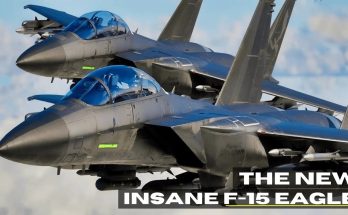F-47 U.S. 6th Generation Fighter Development Unveiled – Expected Features
The F-47, a proposed U.S. 6th generation fighter aircraft, represents the cutting edge of military aviation technology. While still in early stages of development, it is expected to incorporate a range of advanced features that will significantly enhance the capabilities of the United States Air Force and potentially change the landscape of aerial combat. Here’s an overview of the expected features and innovations that the F-47 is likely to bring to the table:
1. Stealth and Advanced Radar Signature Reduction
The F-47 will likely continue the trend of stealth technology that was first seen in the F-22 Raptor and further refined in the F-35 Lightning II. Enhanced stealth features will be a priority, with a focus on reducing the aircraft’s radar cross-section (RCS) and infrared signature. It’s expected to have cutting-edge radar-absorbent materials, new shapes, and electronic countermeasures to avoid detection by enemy radar systems, making it incredibly difficult to track or target.
2. Artificial Intelligence and Autonomous Capabilities
One of the most anticipated features of the F-47 is the integration of artificial intelligence (AI). The aircraft may be equipped with an AI system capable of managing a wide range of tasks, from mission planning to real-time flight decisions. AI could assist in analyzing vast amounts of battlefield data, identifying threats, and recommending tactics in complex combat environments. There is also the potential for limited autonomous capabilities, allowing the F-47 to operate independently in certain scenarios or assist human pilots with real-time decision-making.
3. Supercruise and Advanced Propulsion
Supercruise, the ability to fly at sustained speeds above the speed of sound without using afterburners, is expected to be a key feature of the F-47. This capability would provide a significant tactical advantage, allowing the aircraft to engage targets faster and more efficiently while conserving fuel. The F-47 is also expected to incorporate cutting-edge propulsion technologies, such as new engines that provide better thrust, higher fuel efficiency, and improved maneuverability.
4. Next-Generation Cockpit and Human-Machine Interface
The F-47 will likely feature a highly advanced cockpit with a next-generation human-machine interface (HMI). This could include a holographic display system, voice command recognition, and touch-sensitive surfaces that allow pilots to interact seamlessly with the aircraft’s systems. The cockpit might also utilize augmented reality (AR) to provide real-time overlays of battlefield data, enhancing situational awareness and making it easier for the pilot to respond to dynamic threats.
5. Hypersonic Weapons Integration
With the ongoing development of hypersonic weapons, the F-47 is expected to be compatible with these next-generation munitions. Hypersonic missiles, capable of traveling at speeds greater than Mach 5, could provide a significant advantage in terms of speed and striking power. The ability to launch and guide hypersonic weapons would give the F-47 a decisive edge in both air-to-air and air-to-ground combat scenarios.
6. Enhanced Networking and Sensor Fusion
The F-47 will likely incorporate advanced sensor fusion, meaning it will be able to integrate data from various sources — including satellites, ground stations, and other aircraft — to create a unified, comprehensive view of the battlefield. This could involve a suite of onboard sensors, such as radar, infrared, and electronic warfare systems, working together to detect and target threats. Additionally, the F-47 may serve as a node in a larger, interconnected network of assets, allowing it to share data in real time and act as a force multiplier.
7. Longer Range and Extended Endurance
With a focus on increased range and endurance, the F-47 will likely feature more advanced fuel management and storage systems, along with a more efficient powerplant. This would allow the aircraft to operate over extended distances without needing frequent refueling, making it ideal for long-range missions. Additionally, the integration of advanced materials will likely reduce the weight of the aircraft, further enhancing its efficiency.
8. Directed Energy Weapons (DEWs)
Another expected feature of the F-47 is the potential for directed energy weapons (DEWs), such as lasers or microwave-based systems. These weapons would allow the aircraft to disable or destroy enemy threats, including missiles, drones, and aircraft, using concentrated energy beams. DEWs offer significant advantages, including near-instantaneous target engagement and a virtually limitless supply of ammunition, as long as the aircraft’s power systems can support them.
9. Enhanced Maneuverability and Supermaneuverability
Taking inspiration from the agility of aircraft like the Su-35 and F-22, the F-47 is expected to feature advanced aerodynamic designs and thrust-vectoring technologies that will allow it to perform extreme maneuvers. Supermaneuverability — the ability to perform complex aerial maneuvers at high angles of attack — will be a critical component in dogfights, enabling the F-47 to outmaneuver adversaries in close combat situations.
10. Advanced Electronic Warfare (EW) Systems
Electronic warfare will be another vital capability of the F-47. Equipped with state-of-the-art EW systems, the aircraft would be capable of jamming enemy radar, disrupting communications, and interfering with the guidance systems of incoming missiles. This would make it not only a powerful offensive platform but also a formidable force in degrading the effectiveness of enemy air defenses.
Conclusion
The F-47, as a 6th-generation fighter, is set to build upon the advancements of its predecessors, like the F-22 and F-35, while introducing innovative technologies that will revolutionize air combat. With capabilities such as AI integration, supercruise, hypersonic weapon compatibility, and cutting-edge stealth, the F-47 will ensure that the United States maintains a decisive edge in the skies for decades to come.



